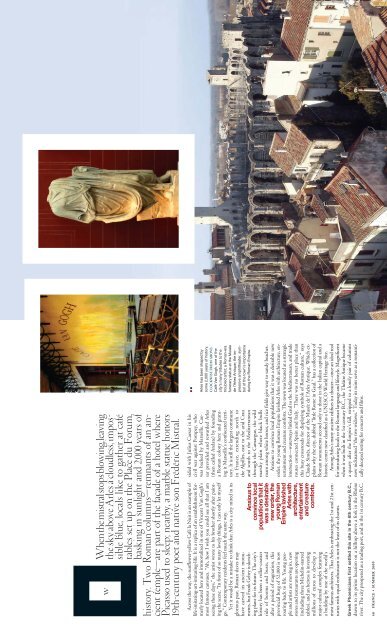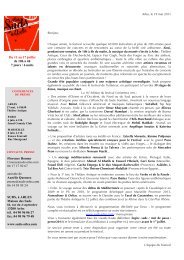GEO correspond-il à vos attentes ? - Les Suds à Arles
GEO correspond-il à vos attentes ? - Les Suds à Arles
GEO correspond-il à vos attentes ? - Les Suds à Arles
Create successful ePaper yourself
Turn your PDF publications into a flip-book with our unique Google optimized e-Paper software.
w<br />
When the mistral stops blowing, leaving<br />
the sky above <strong>Arles</strong> a cloudless, impossible<br />
blue, locals like to gather at café<br />
tables set up on the Place du Forum,<br />
basking in sunlight and 2,000 years of<br />
history. Two Roman columns—remnants of an ancient<br />
temple—are part of the façade of a hotel where<br />
Picasso used to sleep; nearby, a marble statue honors<br />
19th-century poet and native son Frédéric Mistral.<br />
<strong>Arles</strong> has been shaped by<br />
some 2,000 years of history.<br />
CloCkwise from above:<br />
Café Van Gogh, one of the<br />
city’s many tributes to the<br />
troubled artist; a Roman-era<br />
funerary statue at the Musée<br />
de l’<strong>Arles</strong> Antique; the impressive<br />
amphitheater, symbol<br />
of the town’s importance<br />
during the Roman Empire.<br />
sided with Julius Caesar in his<br />
civ<strong>il</strong> war against Pompey, who<br />
was backed by Marse<strong>il</strong>le. Caesar<br />
preva<strong>il</strong>ed and rewarded <strong>Arles</strong><br />
(then called Arelate) by founding<br />
a Roman colony here and granting<br />
it Marse<strong>il</strong>le’s confiscated territory.<br />
It is st<strong>il</strong>l the largest commune<br />
in France, extending north to<br />
the Alp<strong>il</strong>les, east to the arid Crau<br />
and south to the Mediterranean<br />
through the Camargue, the w<strong>il</strong>d<br />
marshy plain where black bulls<br />
roam among white horses, and rice fields give way to sandy beaches.<br />
Anxious to convince local populations that it was a desirable new<br />
order, the young Roman Empire lavished <strong>Arles</strong> with architecture, entertainment<br />
and creature comforts. The town was located at a strategic<br />
intersection—waterways linked Gaul to the Mediterranean, and trade<br />
routes connected Spain and Italy. “There was no better place than<br />
this busy crossroads for displaying symbols of Roman culture,” says<br />
Claude Sintès, director of the Musée de l’<strong>Arles</strong> Antique. Which explains<br />
why the city, dubbed “little Rome in Gaul,” has a collection of<br />
Roman monuments second only to those in the Italian capital and a<br />
historic center now classified as a UNESCO World Heritage Site.<br />
Among <strong>Arles</strong>’s many ancient edifices is a theater—once an ideal tool<br />
for introducing locals to the Roman language and lifestyle. Magnificent<br />
when it was bu<strong>il</strong>t in the 1st century B.C., the Théâtre Antique became<br />
a quarry after the Empire’s fall, stripped to a lonely pair of columns<br />
now nicknamed “the two widows.” Today its ruins serve as a romantically<br />
decayed setting for concerts and f<strong>il</strong>ms.<br />
Across the way, the sunflower-yellow Café la Nuit is an example of<br />
life-imitating-art-imitating-life: It is a replica of an establishment formerly<br />
located here and immortalized in one of Vincent Van Gogh’s<br />
most famous canvases. “Ah, how I wish you could see all that I am<br />
seeing these days,” the artist wrote to his brother shortly after painting<br />
the scene. “In front of so many lovely things, I can only let myself<br />
go.” Contemporary residents feel much the same way.<br />
Yet it would be a mistake to think that <strong>Arles</strong> is a city mired in its<br />
glorious past. Roman slaves may<br />
have carved its ancient monuments,<br />
but Frank Gehry is sketch-<br />
Anxious to<br />
ing plans for its future. The city’s<br />
convince local<br />
history has been a roller-coaster populations that it<br />
ride of booms and busts, and was a desirable<br />
after a period of stagnation, this<br />
new order, the<br />
provincial burg of 52,000 is now<br />
young Roman<br />
roaring back to life. Young peo- Empire lavished<br />
ple and artists are moving in, new<br />
<strong>Arles</strong> with<br />
stores and restaurants are opening<br />
architecture,<br />
(including three Michelin-starred<br />
entertainment<br />
tables), and an heiress is investing<br />
and creature<br />
m<strong>il</strong>lions of euros to develop a<br />
comforts.<br />
major cultural complex featuring<br />
a bu<strong>il</strong>ding by one of the world’s<br />
most famous architects. That <strong>Arles</strong> is embracing the 1st and 21st centuries<br />
with equal enthusiasm is not the least of its charms.<br />
Greek Phoenicians first settled this site in the 6th century B.C.,<br />
drawn to its prime location on a h<strong>il</strong>ltop above a fork in the Rhône<br />
river. The city prospered as a trading port, and in the 1st century B.C.<br />
40 France • summer 2009





